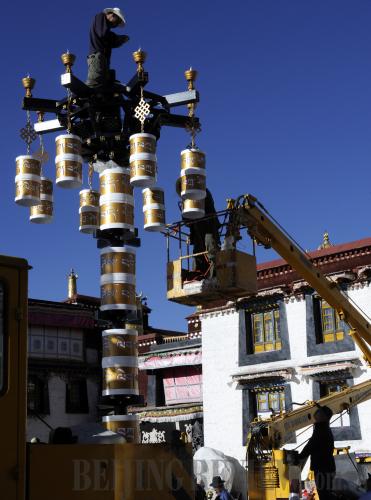|
 |
|
A NEW LOOK: Workers install new street lamps in Lhasa's old city on June 17 (XINHUA) | Preserving culture
Barkhor has many historical buildings and cultural relics, which are very valuable and should be preserved, said Qimei Cering, deputy head of Lhasa's Chengguan District.
He said that relevant government departments worked out a meticulous and feasible program to eliminate safety hazards and protect the religious sites.
The plan is in strict compliance with China's Law on the Protection of Cultural Relics and the International Charter for the Conservation and Protection of Monuments and Sites, according to Qimei Cering.
The conservation project can protect cultural relics from the hidden dangers of water and fire, two natural enemies of relics, said Nyima Tsering, a monk at Jokhang Monastery.
He said that the wires crisscrossing the temple posed a great fire hazard. Moreover, the foundation and some wall paintings were badly damaged due to poor drainage. The conservation project put the wires under the ground and cleared out the drains.
Some residents, tourists and netizens worry that the project will deprive the old city of its uniqueness.
Measures have been taken to maintain the original appearance of ancient buildings, said Ma Xinming, a publicity official of Lhasa.
According to Ma, before the conservation project started, pictures had been taken of ancient buildings in the old city for reference in repair and reconstruction.
Moreover, many Tibetan architects were invited to advise on preservation of cultural relics, said Wang Jian, chief architect of the Tianjin Real Estate Appraise Survey and Design Institute. The institute measured many buildings in the old city in preparation for the conservation project.
"We have made efforts to preserve the original appearance of ancient buildings in the reconstruction process, and tried our best to avoid unnecessary repairs, moves and component replacements," said Ceda, deputy chief of the construction headquarters of Lhasa's conservation project.
In addition to worries about the project's impact on cultural relics, there are also rumors about forced resettlements of residents in the old city. Ma said that the 80,000 permanent residents in the old city will not be moved out, for in that case, the old town would be empty.
"My shop is here, and my home is here. We have lived here for more than a decade. No one has asked us to move out," said Yangjin, who owns a shop in Barkhor. She expects that her business will become more prosperous after the conservation project is complete.
Email us at: wanghairong@bjreview.com | 